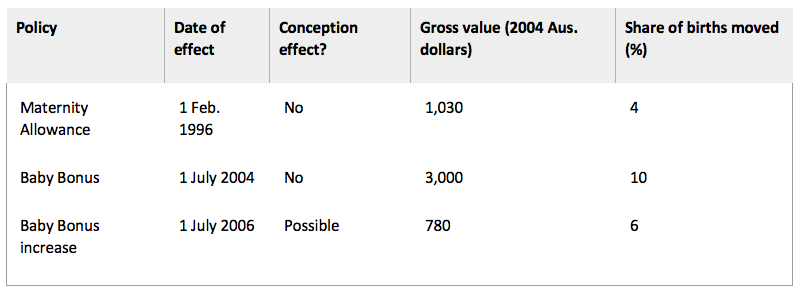Research has shown that early childhood experiences can have large effects on later life outcomes. Yet little is known about the lasting effects of family income in childhood. The main difficulty in determining the impact of family income in childhood is that children who differ in family income typically differ in many other important ways as well. We do not have randomised control trials assigning income to some families and not to others.
The Australian Baby Bonus, however, provides a rare ‘natural experiment’ on the effect of family income at birth. Families of those born on or after 1 July 2004 received a $3,000 cash payment while otherwise identical families of those born beforehand did not.
The Baby Bonus also resulted in over 1,000 births being delayed. This caused some concern — were parents and doctors making decisions that could harm children?
Our research tackled the two questions that arise from the above: did the additional support provided by the $3,000 Baby Bonus affect children’s educational outcomes and did the shift in births inflict lasting harm upon children?
For the first question, we used Year 3 NAPLAN test scores covering 300,000 students born from 2003 to 2005. Use of big data means that we can detect even tiny effects. Our ability to statistically detect the effect of the Baby Bonus is equivalent to the ability to detect the effect of a $90,000 cash bonus in a survey of 20,000 households. We compared differences in scores for those born before and after the Baby Bonus accounting for ‘normal’ differences across months.
For the second question, we looked for any sharp differences around 1 July 2004 and two other major birth shifting events. These were the reintroduction of Maternity Allowance in 1996 and an increase in the Baby Bonus in 2006. In the former, a lump sum payment of $840.60 was payable to all mothers at the time of childbirth; while in the latter, the Baby Bonus was increased to $4,000 from $3,000. Table 1 compares the three birth shifting events and their effects.
Table 1. Births Delayed in Response to Changes in Cash Transfers at Birth

Impact on child outcomes
We used a difference‐in‐differences design to assess the effect of the additional family income provided by the Baby Bonus on a combined reading and numeracy test score in grade three NAPLAN.
There is no evidence that the A$3,000 of additional family income improved outcomes in aggregate. While there is some evidence of a modest improvement for children from disadvantaged families, this effect is sensitive to assumptions.
There are a variety of explanations for this finding. The first is simply that the boost to family income was small — a one-off increase of around 1 to 2 weeks average earnings. Despite the large body of evidence on the importance of early life experiences to later outcomes (see Currie and Almond (2011)), in a wealthy country with high quality public services, such as Australia, the average returns to additional investments in early childhood may be relatively low. Alternatively, even if such investment opportunities exist, parents may be unaware, unwilling or unable to make them.
What this means for policy is that modest boosts to family income, while of value to parents, should not be expected to have appreciable effects for their children’s cognitive skills. Improving such outcomes through family income supplementation alone is likely to be very expensive. That is not to discount other motivations for family benefits, such as redistribution or compensation for the costs of parenting.
Impact of birth shifting
We also find no clear evidence of harm from the unintended birth shifting, despite the concern that birth shifting would lead to hospital congestion, and thus poorer care and infant health outcomes.
Using discontinuities around three large policy changes, we find significantly lower university offer rates, but little difference in test scores and, if anything, better early development indicators. These conflicting differences are not causal estimates and may simply reflect unobservable differences in family background. Interestingly, there are very large differences in family characteristics of those who shifted births as opposed to those who did not.
This mix of findings suggests that sharp date‐of‐birth cut‐offs are best argued against on a precautionary basis, if at all. There is no ‘smoking gun’ indicating long‐run harm for policy changes of the sizes examined here.
This provides some comfort that modest birth shifting by parents and care providers, as seen around weekends, holidays and conferences, is unlikely to harm child outcomes. It seems likely birth shifting was managed in a way that did not compromise child health.
Conclusion
Several individuals have suggested to us that they would not have expected any lasting educational effects from the relatively minor intervention represented by the Baby Bonus. Yet by using big data, we can detect effects that would be imperceptible in individual students. Big data is to a social scientist what a modern telescope is to an astronomer — a tool that enables us to observe well beyond the limits of human perception. Observing marginal gains from marginal increases in income is our equivalent to the astronomer observing planets orbiting distant stars.
What’s more, policy advocates frequently propose modest interventions claiming large benefits. This research analyses a modest intervention that has no discernible impact. That small changes should have little or no discernible impact seems intuitive, however, policy-making is often beset by wishful thinking, particularly in fiscally constrained times. Evidence of the kind presented here is important both in re-directing resources from ineffective policies to effective ones but also in setting sensible expectations in the community about the potential effects of policy.
This post is summarised from a journal article by Nathan Deutscher and Robert Breunig at the Crawford School of Public Policy. You can also read their free access working paper here.






Recent Comments